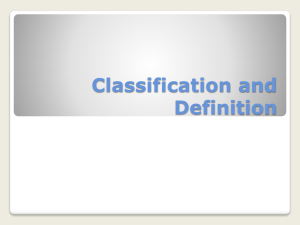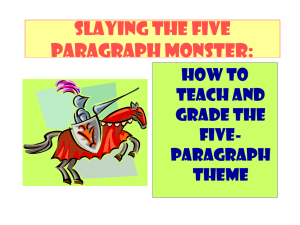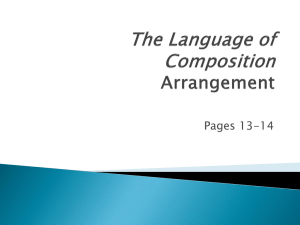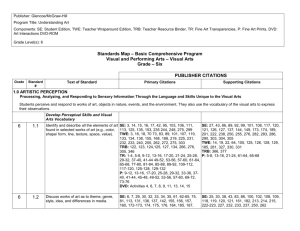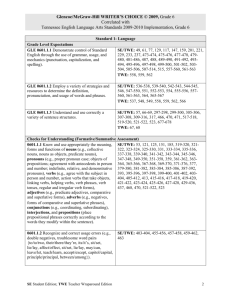Language Assessment
advertisement
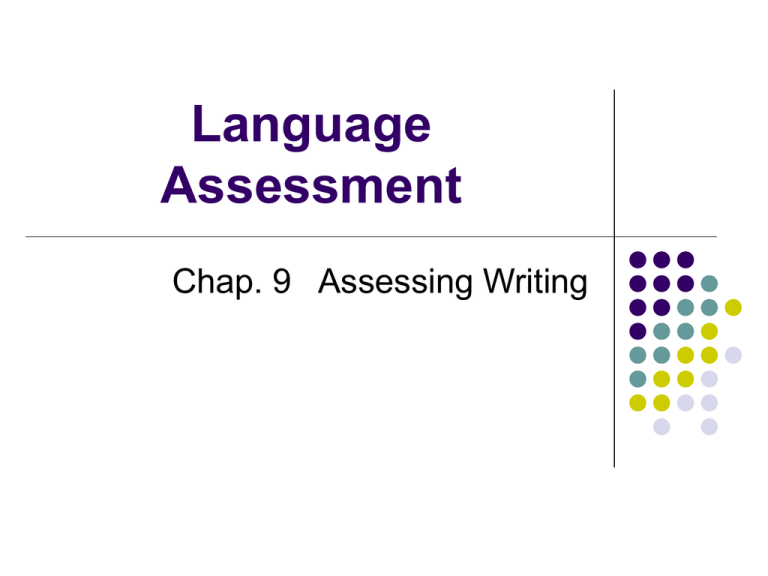
Language Assessment Chap. 9 Assessing Writing Genres of Writing 1. Academic writing Papers and general reports/essays, compositions/academically focused journals/theses/dissertations 2. Job-related writing Messages/letters, emails/memos/reports/labels/signs/advertisements/a nnouncements 3. Personal writing Greeting cards/invitations/notes/tax forms/diaries/fiction/personal journals Types of Writing Performance 1. Imitative It is a level at which learners are trying to master the mechanics of writing. Form (letters, words, punctuation, and brief sentences) is the primary while context and meaning are of secondary concern. 2. Intensive It includes skills in producing appropriate vocabulary, collocations, idioms, and correct grammatical features. Most assessment tasks are concerned with a focus on form. Continue 3. Responsive At this level, form-focused attention is mostly at the discourse level, with a strong emphasis on context and meaning. Assessment tasks require learners to connect sentences into a paragraph and create a sequence of two or three paragraphs. 4. Extensive Extensive writing requires using all the processes and strategies of writing to write an essay, a term paper, a project report, or even a thesis. Imitative Writing 1. copying There is nothing innovative or modern about directing a test-taker to copy letters or words. Example: (Copy the words) bit bet but gin din pin ___ ___ ___ ___ ___ ___ Listening cloze selection tasks Test takers listen a passage and then write the missing words (p. 222) 3. Picture-cued tasks Familiar pictures are displayed, and test-takers are told to write the word that the picture presents. 4. Form completion tasks The use of a simple form (registration, application, etc.) that asks for name, address, phone number, and other data. 5. Converting numbers and abbreviations to words 9:00 _______ 5:45 ___________ Tues. _______ 5/3 ____________ 726 S. Main St. _________________ Spelling Tasks & Detecting Phoneme-Grapheme Correspondences Spelling tests Picture-cued tasks Multiple-choice techniques Example: He washed his hands with ______ A. soap B. sope C. sop D. soup Matching phonetic symbols d/e/ ____ l /ai/ /k/ ______ Intensive Writing The same as controlled writing or guided writing. At this level, students produce language to display their competence in grammar, vocabulary or sentence formation, and not necessarily to convey meaning for an authentic purpose. Dictation and Dicto-Comp Dictation is the rendition in writing of what one hears aurally. Dicto-comp: A paragraph is read at normal speed, usually two or three times; then the teacher asks students to rewrite the paragraph from the best of their recollection. Variation: The teacher, after reading the passage, distributes a handout with key words from the paragraph as cues for students. Grammatical Transformation Tasks The tasks are: Change the tenses in a paragraph. Change full forms of verbs to reduced forms. Change statements to yes/no or whquestions. Change questions into statements. Combine two sentences into one using a relative pronoun. Change from active to passive voice. Picture-Cued Tasks Short sentences. A drawing of some simple action is shown; the test-taker writes a brief sentence. (p. 227) Picture description. Using the prepositions: on , over, under, next to, around to describe as in a picture on p. 192. Picture sequence description. A sequence of three to six pictures depicting a story line can provide a suitable stimulus for written task. (p.228) Vocabulary Assessment Tasks The major techniques used to assess vocabulary are (a) defining and (b) using a word in a sentence. Ordering Tasks Reordering words in a sentence 1. cold/winter/is/weather/the/in/the 2. Studying/what/you/are 3. next/clock/the/the/is/picture/to Short-Answer & Sentence Completion Tasks Example: 1. A: Who’s that ? B: ___________ Gina. A: Where’s she from? B: ____________ Italy. 2. Write three sentences describing your preferences: #6a: a big, expensive car or a small, cheap car; #6b: a house in the country or an apartment in the city; #6c: money or good health. 6a.________ 6b.______ 6c.__________ Issues in Assessing Responsive and Extensive Writing The genres of text here are: Short reports/responses to the reading of an article or story/summaries of articles or stories/brief narratives or descriptions/ interpretations of graphs, tables, and charts. Writers become involved in composing, real writing, as opposed to display writing. Continue 1. Authenticity. Assessment is typically formative, not summative, and positive washback is more important than practicality and reliability. 2. Scoring. Not only the form abut also the function of the text are important in evaluation. 3. Time. Responsive writing, along with extensive writing, relies on the essential drafting process for its ultimate success. Designing: responsive & Extensive Writing Paraphrasing. It is to say something in one’s own words. It can avoid plagiarizing and offer some variety in expression. Scoring is judged by how the test-taker conveys the same or similar message, with discourse, grammar, and vocabulary as secondary evaluations. Guided Question and Answer The test administrator poses a series of questions which serve as an outline of the emergent written text. Guided Written Stimuli 1. Where did this story take place? (setting) 2. Who were the people in the story? 3. What happened first? And then? And then? 4. Why did _________ do _______ (reasons)? 5. What did ____ think about ____? (opinion) 6. What happened at the end? (climax) 7. What is the moral of the story? (evaluation) Paragraph Construction Tasks Assessment of paragraph development takes on the following forms. 1. Topic sentence writing. The writing of a topic sentence (its presence/absence, its effectiveness in stating the topic). 2. Topic development within a paragraph. Four criteria to assess the quality: The clarity of expression of ideas/ the logic of the sequence and connections/the cohesiveness or unity/the overall effectiveness or impact Continue 3. Development of main and supporting ideas across paragraphs. The elements in evaluating a multi-paragraph essay: Addressing the topic, main idea, or principal purpose. Organizing and developing supporting ideas Using appropriate details to undergird supporting ideas. Showing facility and fluency in the use of language. Demonstrating syntactic variety. Strategic Options 1. Attending to task. A set of directives is stated or implied by the teacher or the conventions of the genre. Four types: compare/contrast, problem/solution, pros/cons, and cause/effect. 2. Attending to genre. Reports, Summaries of readings/lectures/videos, Responses to readings/lectures/videos, Narration, description, persuasion/argument, and exposition, Interpreting statistical, graphic data, Library research paper. Test of Written English (TWE) TWE is a standardized test of writing ability and has gained a reputation as a well-respected measure of written English. The TWE is a timed impromptu test in which test-takers are under a 30-minute time limit and are not able to prepare ahead of time. Sample TWE Topic Some people say that the best preparation for life is learning to work with others and be cooperative. Others take the opposite view and say that learning to be competitive is the best preparation. Discuss these positions, using concrete examples of both. Tell which one you agree with and explain why. Six Steps to Maximize success on the TWE 1. Carefully identify the topic. 2. Plan your supporting ideas. 3. In the introductory paragraph, restate the topic and state the organizational plan. 4. Write effective supporting paragraphs. 5. Restate your position and summarize in the concluding paragraph. 6. Edit sentence structure & rhetorical expression. (Scoring Guide p. 239) Scoring Methods for Responsive and Extensive Writing Three major approaches to scoring writing performance: holistic, primary trait, and analytical. Holistic: A single score is assigned to an essay. Primary trait: The achievement of the primary purpose, or trait, of an essay is the only factor rated. Analytical: the written text is broken down into a number of subcategories (organization, grammar) and each subcategory gets a separate rating. Holistic Scoring Advantages: Fast evaluation/high inter-rater reliability/ easily interpreted by lay persons/emphasize the writer’s strengths/applicability to writing across many different disciplines Disadvantages: No diagnostic information/not equally well apply to all genres/training in raters/one score only Primary trait Scoring If the purpose or function of an essay is to persuade the reader to do something, the score for the writing would rise or fall on the accomplishment of that function. Organization, supporting details, fluency, syntactic variety, and other features will also be evaluated. Advantage: focus on function. Analytic Scoring Classroom evaluation of learning is best served through analytic scoring. Brown and Bailey (1984) designed an analytic scoring scale that specified five major categories and five different levels in each category, ranging from “unacceptable” to “excellent”. Five categories: organization, logical development of ideas, grammar, punctuation/spelling/mechanics, and style and quality of expression. (p.244-245) Continue Content 30 Organization 20 Vocabulary 20 Syntax 25 Mechanics 5 Total 100 Analytic scoring offers more washback and helps to call the writer’s attention to problem areas, but it requires more time for teachers to attend to details within each of the categories.



